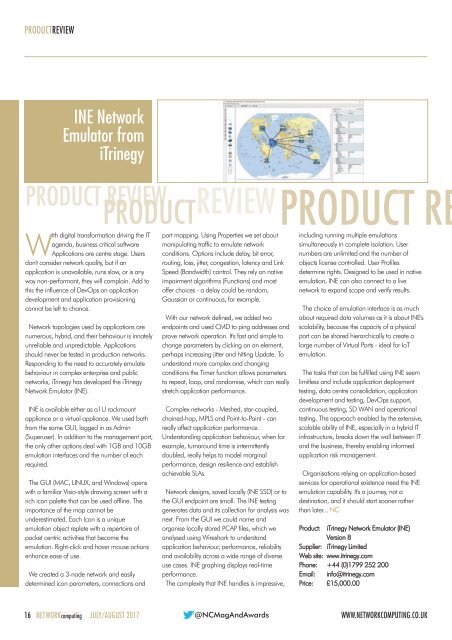You also want an ePaper? Increase the reach of your titles
YUMPU automatically turns print PDFs into web optimized ePapers that Google loves.
PRODUCTREVIEW<br />
INE Network<br />
Emulator from<br />
iTrinegy<br />
PRODUCT REVIEW<br />
PRODUCT<br />
REVIEWPRODUCT RE<br />
With digital transformation driving the IT<br />
agenda, business critical software<br />
Applications are centre stage. Users<br />
don't consider network quality, but if an<br />
application is unavailable, runs slow, or is any<br />
way non-performant, they will complain. Add to<br />
this the influence of DevOps on application<br />
development and application provisioning<br />
cannot be left to chance.<br />
Network topologies used by applications are<br />
numerous, hybrid, and their behaviour is innately<br />
unreliable and unpredictable. Applications<br />
should never be tested in production networks.<br />
Responding to the need to accurately emulate<br />
behaviour in complex enterprise and public<br />
networks, iTrinegy has developed the iTrinegy<br />
Network Emulator (INE).<br />
INE is available either as a1U rackmount<br />
appliance or a virtual appliance. We used both<br />
from the same GUI, logged in as Admin<br />
(Superuser). In addition to the management port,<br />
the only other options deal with 1GB and 10GB<br />
emulation interfaces and the number of each<br />
required.<br />
The GUI (MAC, LINUX, and Windows) opens<br />
with a familiar Visio-style drawing screen with a<br />
rich icon palette that can be used offline. The<br />
importance of the map cannot be<br />
underestimated. Each Icon is a unique<br />
emulation object replete with a repertoire of<br />
packet centric activities that become the<br />
emulation. Right-click and hover mouse actions<br />
enhance ease of use.<br />
We created a 3-node network and easily<br />
determined icon parameters, connections and<br />
port mapping. Using Properties we set about<br />
manipulating traffic to emulate network<br />
conditions. Options include delay, bit error,<br />
routing, loss, jitter, congestion, latency and Link<br />
Speed (Bandwidth) control. They rely on native<br />
impairment algorithms (Functions) and most<br />
offer choices - a delay could be random,<br />
Gaussian or continuous, for example.<br />
With our network defined, we added two<br />
endpoints and used CMD to ping addresses and<br />
prove network operation. It's fast and simple to<br />
change parameters by clicking on an element,<br />
perhaps increasing jitter and hitting Update. To<br />
understand more complex and changing<br />
conditions the Timer function allows parameters<br />
to repeat, loop, and randomise, which can really<br />
stretch application performance.<br />
Complex networks - Meshed, star-coupled,<br />
chained-hop, MPLS and Point-to-Point - can<br />
really affect application performance.<br />
Understanding application behaviour, when for<br />
example, turnaround time is intermittently<br />
doubled, really helps to model marginal<br />
performance, design resilience and establish<br />
achievable SLAs.<br />
Network designs, saved locally (INE SSD) or to<br />
the GUI endpoint are small. The INE testing<br />
generates data and its collection for analysis was<br />
next. From the GUI we could name and<br />
organise locally stored PCAP files, which we<br />
analysed using Wireshark to understand<br />
application behaviour, performance, reliability<br />
and availability across a wide range of diverse<br />
use cases. INE graphing displays real-time<br />
performance.<br />
The complexity that INE handles is impressive,<br />
including running multiple emulations<br />
simultaneously in complete isolation. User<br />
numbers are unlimited and the number of<br />
objects license controlled. User Profiles<br />
determine rights. Designed to be used in native<br />
emulation, INE can also connect to a live<br />
network to expand scope and verify results.<br />
The choice of emulation interface is as much<br />
about required data volumes as it is about INE's<br />
scalability, because the capacity of a physical<br />
port can be shared hierarchically to create a<br />
large number of Virtual Ports - ideal for IoT<br />
emulation.<br />
The tasks that can be fulfilled using INE seem<br />
limitless and include application deployment<br />
testing, data centre consolidation, application<br />
development and testing, DevOps support,<br />
continuous testing, SD WAN and operational<br />
testing. The approach enabled by the extensive,<br />
scalable ability of INE, especially in a hybrid IT<br />
infrastructure, breaks down the wall between IT<br />
and the business, thereby enabling informed<br />
application risk management.<br />
Organisations relying on application-based<br />
services for operational existence need the INE<br />
emulation capability. It's a journey, not a<br />
destination, and it should start sooner rather<br />
than later... NC<br />
Product: iTrinegy Network Emulator (INE)<br />
Version 8<br />
Supplier: iTrinegy Limited<br />
Web site: www.itrinegy.com<br />
Phone: +44 (0)1799 252 200<br />
Email: info@itrinegy.com<br />
Price: £15,000.00<br />
16 NETWORKcomputing JULY/AUGUST 2017 @NCMagAndAwards<br />
WWW.NETWORKCOMPUTING.CO.UK

















